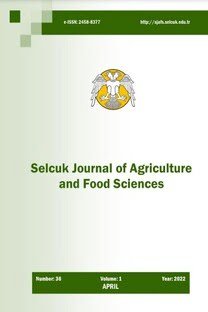Azospirillum brasilense ve iki Rhizobium türünün bazı yaygın fasulye (Phaseolus vulgaris L.) çeşitlerinde nodulasyona etkisi
Rhizobium, fasulye, Phaseolus vulgaris, nodul gelişimi, Azospirillum brasilense
The effects of Azospirillum brasilense and two Rhizobium species on the nodılation of bean (Phaseolus vulgaris L.) cultivars
Rhizobium, bean, Phaseolus vulgaris, nodulation, Azospirillum brasilense,
___
- Burdman, S., Kigel, J., Okon, Y., 1997. Effects of Azospirillum brasilense on nodulation and growth of common bean (Phaseolus vulgaris L). Soil Bi- ology and Biochemistry 29:923-929.
- Buttery, B.R., Park S.J., Van Berkum, P., 1997.Effects of common bean (Phaseolus vulgaris L.) cultivar and Rhizobium strain on plant growth, seed yield and nitrogen content. Canadian Journal of Plant Science 77: 347-351.
- Chaverra, M.H., Graham, P.H., 1992. Cultivar varia- tion in traits affecting early nodulation of common bean. Crop Science 32: 1432-1436.
- Graham, P.H., 1981. Some problems of nodulation and symbiotic nitrogen fixation in Phaseolus vul- garis L. : a review. Field crops research 4: 93-112.
- Graham, P., Ranalli, P., 1997. Common bean (Phaseo- lus vulgaris L.). Field crop research 53: 131-146.
- Hardarson, G., Bliss, F.A., Cigales-Rivaro, M.R., Henson, R.A., Kipe-Nolt, J.A., Longeri, L., Man- rique, A., Pena-Cabrilas, J.J. Pereira, P.A., Sanabria, C.A., Tsai, S.M., 1993. Genotypic varia- tion in biological nitrogen fixation by common bean. Plant and Soil 152: 59-70.
- Hernandez-Lucas, I., Segavia, L., Martinez-Romero, E., Pueppke, S.G., 1995. Phylogenetic relation- ships and host range of Rhizobium spp. that nodu- late Phaseolus vulgaris L. Applied and Environ- mental Microbiology 61: 2775-2779.
- Isoi, T., Yoshida, S., 1991. Low nitrogen fixation of common bean (Phaseolus vulgaris). Soil Science and Plant Nutrition 37:559-563.
- Kapusta, G., Rouwenhorst, D., 1973. Influence of inoculum size on Rhizobium japonicum serogroup distribution frequency in soybean nodules. Agron- omy Journal 65:916-919.
- Kundu, B.S., Kuhad, M.S, Nanwal, A.S., 1993. Nodu- lation, nitrogen fixation and biomass of r ajmash (Phaseolus vulgaris L.) as influenced by Azospiril- lum and Rhizobium inoculants. Environment and Ecology 11: 581-583.
- Martinez, E., Lores, M., Brom, S., Romero, D., Davil- la, G., Palacios, R., 1988. Rhizobium phaseoli: A molecular genetics view. Plant and Soil 108: 179- 184.
- Neyra, C.A., Atkinson, A., Olubayi, O., 1995. Coag- gregation of Azospirillum with other bacteria: basis for functional diversity. p. 429-439. In I. Fendrick et al. (ed.) Azospirillum VI and Related Microor- ganisms, Genetics, Physiology and Ecology. Springer Verlag, Berlin, Heidelberg, Germany.
- Okon, Y., Albrecht, S.L., Burris, R.H., 1977. Methods for growing Spirillum lipoferum and counting it in pure culture and in associations with plants. Ap- plied and Environmental Microbiology 33:85-88.
- Pacovsky, R.S., Bayne, H.G., Bethanfalvy, G.J., 1984. Symbiotic interactions between strains of Rhizo- bium phaseoli and cultivars of Phaseolus vulgaris L. Crop Science 24: 101-105.
- Plazinske, J., Rolfe, B.G., 1985. Influence of Azospirillum strains on the nodulation of clovers by Rhizobium strains. Applied and Environmental Microbiology 49: 984-989.
- Rodriguez-Navarro, D.N., Buendia, A.M., Camacho, M., Lucas, M.M., Santamaria, C., 2000. Characterization of Rhizobium spp. bean isolates from South-West Spain. Soil Biology and Biochemistry 32: 1601-1613.
- Schroder, E.C. 1992. Improvement of phaseolus /Rhizobium symbiosis, with particular reference to the Caribbean region. P. 79-95. In K. Mulangoy et al. (ed.) Biological nitrogen fixation and sustain- ability of tropical agriculture. Wiley and Chiches- ter, London, UK.
- Singh, S.P., Nodari, R., Gepts, P. 1991. Genetic diver- sity in cultivated common bean: I. Allozymes. Crop Science 31: 19-23.
- Tchebotar, V.K., Kang, U.G., Asis, C.A., Akao, S., 1998. The use of GUS-reporter gene to study the effect of Azospirillum-Rhizobium coinoculation on nodulation of white clover. Biology and Fertility of Soils 27: 349-352.
- Vasquez-Arroyo, J., Sessitsch, A., Martinez, E., Pena- Cabriales, J.J., 1998. Nitrogen fixation and nodule occupancy by native strains of Rhizobium on dif- ferent cultivars of common bean ( Phaseolus vul- garis L.) Plant and Soil 204: 147-154.
- Weaver, R.W., Danso, S.K.A., 1994. Dinitrogen fixa- tion. p. 1019-1043. In Weaver et al. (ed.) Methods of soil analysis: Part 2-Microbiological and bio- chemical properties. SSSA, Madison, WI.
- Weaver, R.W., Frederick, L.R., 1974a. Effect of i - n oculum rate competitive nodulation of Glycine max L. Merrill. I. Greenhouse studies. Agronomy Journal 66: 229-232.
- Weaver, R.W., Frederick, L.R., 1974b. Effect of i - n oculum rate on competitive nodulation of Glycine max L. Merrill. II. Field studies. Agronomy Jour- nal 66: 233-236.
- Weaver, R.W., Graham, P.H., 1994. Legume nodule symbionts. p. 199-222. In Weaver et al. (ed.) Methods of soil analysis: Part 2 -Microbiological and biochemical properties. SSSA, Madison, WI.
- ISSN: 1300-5774
- Yayın Aralığı: 3
- Başlangıç: 2018
- Yayıncı: Selçuk Üniv. Ziraat Fak.
İskender YILDIRIM, Ramazan YETİŞTİR
Konya Ovasında su kaynakları kullanımı
NİZAMETTİN ÇİFTÇİ, İlknur KUTLAR, MEHMET ŞAHİN, A. Melih YILMAZ
Beyşehir Yöresi tarım topraklarının verimlilik durumlarının belirlenmesi
MEHMET ZENGİN, Ümmühan ÇETİN, İlknur ERSOY, H. Hüseyin ÖZAYTEKİN
Bazı kil tiplerinin bor adsorpsiyon kapasitelerinin belirlenmesi
MEHMET HAMURCU, H. Hüseyin ÖZAYTEKİN, Fariz D. MIKAİLSOY, Sait GEZGİN
Mehmet ÖĞÜT, Mustafa KILIÇ, A.Raşit BROHİ
Vegetatif olarak üretilen bitkilerde mutasyon ıslahı
